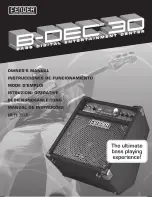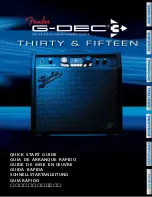
6
7
Front Panel Features
Input
This input has a very wide operating range and will accept high or
low level signals from most acoustic instruments.
Volume
Sets the overall level of the Loudbox. Since the system can produce
sound pressure levels in excess of 120dB peaks, we strongly
suggest that you wear hearing protection when you use the
Loudbox at higher volumes.
Low
Shelving bass, ±10 dB @ 100Hz. Boost here to add weight to the
sound. In general, boost bass at low volumes and flatten it out (or
cut) at higher levels. With the dial set at 12:00, the control is
effectively out of the circuit.
Mid
A resonance style filter, ±12dB @ 1.2kHz. This control affects how
well the instrument blends in or stands out in the mix. At loud
volumes a midrange cut will achieve a more natural sound. With the
dial set at 12:00, the control is effectively out of the circuit.
High
Shelving treble, ±12dB @ 10kHz. Boost highs to add “air” to the
sound of the instrument. With the knob set at 12:00, the control is
effectively out of the circuit.
Brilliance
A Resonance style tone circuit, ±12dB @ 10kHz. Add presence and
“zing” to high frequencies. With the knob set at 12:00, the control is
effectively out of the circuit.
Anti-Feedback
A Fixed level, variable frequency notch filter -14dB @ 20 - 400Hz. If
you encounter low frequency feedback, sweep this control to isolate
and eliminate it. Many guitars will benefit with the Anti Feedback
knob set at about 11:00. The Anti Feedback filter is off at 7:00
position.
Phase
Use the phase switch in conjunction with the Anti Feedback filter to
eliminate acoustic feedback
Reverb
This is a classic spring style reverb that we have meticulously voiced
for acoustic instruments.
Mute
Silences the speaker and the XLR output for tuning or during breaks.
Engage the mute switch when you change instruments to avoid loud
electronic “pops”. The LED next to the mute switch lights when the
mute is engaged.
Power Switch
Lower the Volume or engage the mute switch before you turn on the
amp to avoid surprise beginnings. Flip the power switch up and it
will light, indicating the amp is on.
About Acoustic Feedback
Feedback usually occurs in the lowest octave of your instrument, generally around two notes
about a half step apart. Like blowing air across a bottle, the lower type of feedback (cavity
resonance) starts when the resonant air chamber inside your instrument is excited by the sound
pressure coming out of the speakers. We have found that it is effective to tune out an
instrument’s cavity resonance feedback with the Anti Feedback (notch filter) in the Loudbox. For
acoustic guitar this occurs at G# on the low E-string, or at about 100Hz. Turn the Anti Feedback
knob to about 11:00 to dial out this resonance. Note that the circuit can be effectively defeated
by moving the dial to the OFF (7:00) position.
The higher range of feedback (top resonance) usually starts about a half or whole step above
cavity resonance of the instrument. Top resonance feedback happens when the resonant
frequency of the soundboard of your instrument is excited by the sound pressure coming off the
speakers. For acoustic guitar this occurs at A and above on the low E-string. Push the Phase
switch in and out until you find the position that subdues top resonance feedback.
TM
TM
TM






























